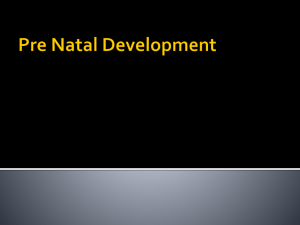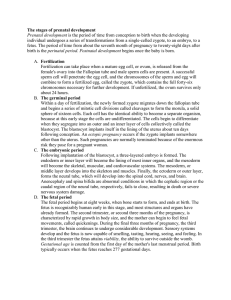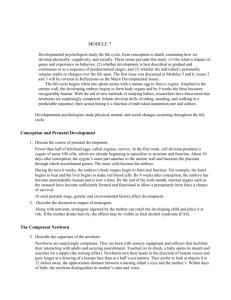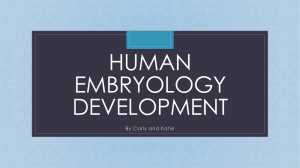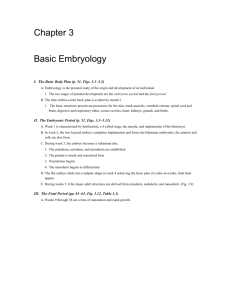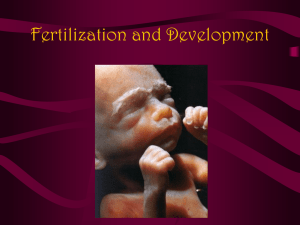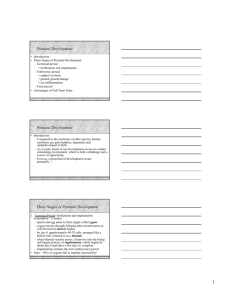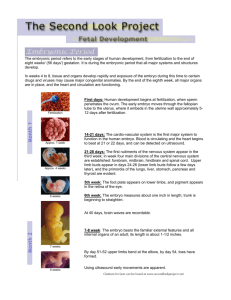Period of the Fetus - People Server at UNCW
advertisement
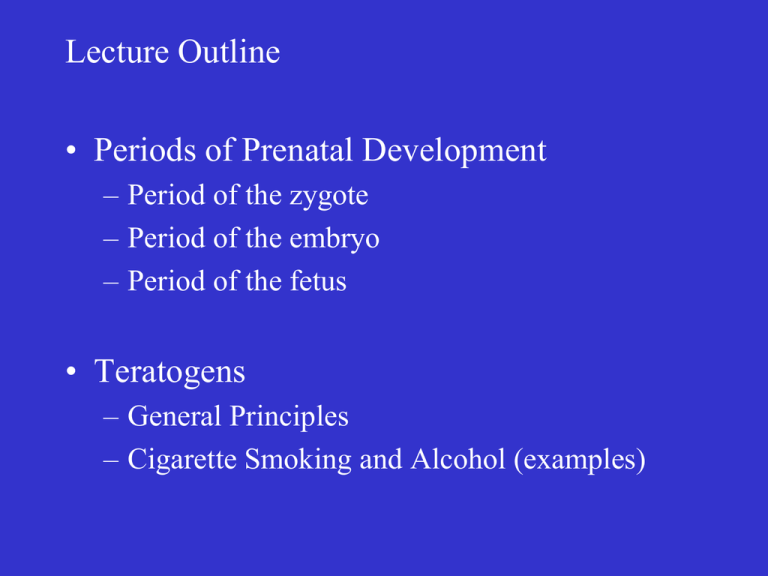
Lecture Outline • Periods of Prenatal Development – Period of the zygote – Period of the embryo – Period of the fetus • Teratogens – General Principles – Cigarette Smoking and Alcohol (examples) Period of the Zygote (or Germinal Period) • Lasts about 2 weeks, from conception through implantation • Zygote undergoes mitosis (cell duplication) as it travels down the fallopian tube to the uterus • By approximately the 4th day after conception, the zygote has become a blastocyst – Fluid-filled ball of cells Two parts of the blastocyst: • Inner cell mass: Cells on the inside of the blastocyst – Will become the embryo • Trophoblast: Cells on the outside of the blastocyst – Will develop into tissues that protect and nourish the embryo • Implantation of the blastocyst into the uterine wall begins approximately 7 to 9 days post-conception • Support structures begin to develop from the trophoblast after implantation Conception and Implantation Support Structures: • Amnion: Membrane that encloses the embryo in amniotic fluid – Cushions organism from injury – Helps to keep temperature constant • Placenta: Organ that is fed by blood vessels from the mother and from the embryo – Connected to the embryo by the umbilical cord – Allows nutrients and oxygen to reach the organism and waste products and carbon dioxide to be carried away – Provides some protection to the embryo by preventing some substances from reaching the embryo’s bloodstream The Placenta and Umbilical Cord • By 2 weeks post-conception, inner cell mass has differentiated into three layers of cells: – Ectoderm --> nervous system, outer layer of skin, nails, teeth, ears, eyes – Mesoderm-->muscles, skeleton, circulatory system, inner layers of skin – Endoderm-->digestive system, lungs, urinary tract, glands Period of the Embryo • Lasts from the 3rd through the 8th week of pregnancy (about 6 weeks) • Ectoderm folds over to form a neural tube (primitive spinal cord) – Top of the neural tube swells to form a brain (about 3.5 weeks post-conception) • External body structures (e.g., arms, legs) and internal organs (e.g., heart) begin to develop • Rapid brain development occurs Period of the Fetus • Lasts from the ninth week post-conception until the end of pregnancy (approximately 38 weeks) Between approximately 9-12 weeks: – Organs, muscles, and nervous system start to become organized and connected • By about 12 weeks, fetus engages in most movements that are present at birth – Exs: kicking, thumb-sucking, grasping, swallowing – Expansion and contraction of lungs (“fetal breathing”) Period of the Fetus (2nd trimester): • Between approximately 16-20 weeks, mother starts to feel movement of fetus Period of the Fetus (3rd trimester): • Fetus triples its weight during the last trimester – Brain growth also continues • Cerebral cortex enlarges • Fetus reacts to a variety of sounds • Age of viability: The point at which a fetus can first survive on its own – Approximately 28 weeks post-conception (without major medical intervention) Period of the Fetus (3rd trimester) con’t: • Near the end of pregnancy, fetus is awake more often than earlier in pregnancy – But still spends most of its time sleeping (like newborns) • REM sleep is present • Fetal activity level is correlated with infant activity level • Teratogen: Any environmental agent that can cause damage during the prenatal period General Principles of Teratogenic Effects: • Dose: Larger doses over longer time periods usually have more negative effects • Heredity: The genetic makeup of the mother and embryo/fetus influence the effect of a teratogen • Timing: Effects of a teratogen vary with the age of the organism at the time of exposure – Sensitive Period: Time during which basic structures are being formed • Each major organ system has its own sensitive period – An organ system is most vulnerable to teratogens during its sensitive period • Cumulative Risk: Effect of a teratogen may be worse if there are other risk factors present (e.g., poor nutrition, lack of medical care, other teratogens) Cigarette Smoking: • Most consistently associated with low birth weight, which is a risk factor for other developmental problems Low Birth Weight and Disabilities © Allyn & Bacon/Longman 2007 Mechanisms (Smoking): • Nicotine constricts blood vessels – Reduces blood flow to the uterus and causes placenta to grow abnormally • Reduces the transfer of nutrients to the fetus • Nicotine raises the concentration of carbon monoxide (and decreases oxygen) in mother’s and fetus’ bloodstreams – Likely to slow fetal growth and may damage CNS • Fetus exposed to carcinogens contained in tobacco Fetal Alcohol Syndrome: • Facial abnormalities and small head • Slow physical growth and small size • Mental retardation and/or other cognitive impairments (in memory, attention, language) • Hyperactivity • Impaired motor coordination Mechanisms (Alcohol): • Interferes with brain development • A woman’s body requires a lot of oxygen to metabolize alcohol – Fetus receives less oxygen
